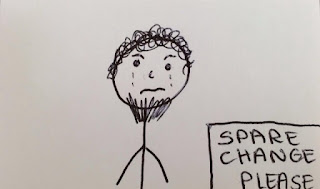I want to begin my sequence by establishing the setting of London and put emphasis on the business of the area. I will go at a time when shoppers and tourists are at a peak (mid-day-5pm) in order to capture the consumerism that will later be contrasted with the poverty of a homeless man. Many documentaries contain an overview of the setting within the first half of the sequence, e.g. 'The Little Things'; this is done so that the audience feels a sense of familiarity throughout the film- I want to create a similar effect within my own product.
I will then insert a low angle clip of the bottom half of the public; this will zoom in on the feet and rapid movement of the shoppers as well as diverting attention to the high label brands seen on the bags of shoppers.
This will be followed by a pan shot of nearby stores, brands and areas of consumer marketing in order to emphasise the superficiality of modern day society. Relating back to my AS research into iconography, signifiers such as London are often associated with things such as upper-class retail, tourism, buses etc, therefore creating the signified stereotype. I want to embrace such a stereotype in order to later knock it down with the reality of life 'beneath the cracks'.
The continuous tracking shots of London Buses will reinforce this sense of stereotype as they are often deemed to be iconic to the city of London; not only this, but I will attempt to do so in such a way that I can also capture footage of the passengers as the bus passes- this will allude to people watching and make the product appear more relatable.
The use of the rewind will act as my technical volta throughout the sequence; this means that it will imply a change in tone or narrative. The rewind will be significant of the disequilibrium that is about to be introduced; as well as this, it will also increase the pace of the sequence, therefore building feelings of suspense from the audience.
Finally, my last clips will include footage of the homeless, therefore having a direct impact on the audience as they are emotionally aroused to feel sympathetic towards those less fortunate. I am unsure as to whether or not I am going to use a script or use a more natural interview technique, however I have decided that it is essential to have majority of this screen time focusing on just the one character. Out of all the short-films I looked at not one consisted of more than 3 characters, instead they tried to follow the story of one role central to the narrative (which is what I hope to do also). This may be because having multiple characters is distracting to the story line and would therefore divert the audience's attention away from the meaning behind my product; I do not want my audience to feel disengaged due to having to keep up with multiple personas.






No comments:
Post a Comment